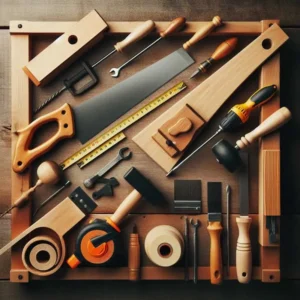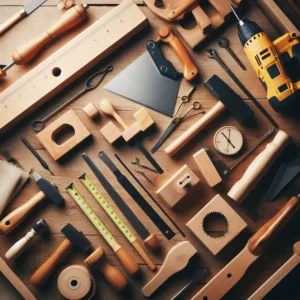Last Updated on May 20, 2024 by Admin
woodworking tools is a creativity and precision tools that allowing individuals to transform raw materials into functional and beautiful pieces. For beginners, understanding and mastering the use of woodworking tools is essential to ensure both safety and success in their projects. This guide aims to provide a comprehensive introduction to the various tools for woodworking available, detailing their functions and offering tips on how to use them effectively. With Taleb Kasimy Trading Co. Dive into this guide to equip yourself with the foundational knowledge needed to embark on your woodworking journey with confidence.

Essential woodworking tools for Beginners
Accurate measurements and precise markings are the foundation of any successful woodworking project. For beginners, investing in high-quality measuring and marking woodworking tools is essential. A reliable tape measure is indispensable for measuring lengths and widths accurately. Look for one that is at least 25 feet long with clear, easy-to-read markings. A combination square is another must-have tool, offering versatility for measuring and marking 90-degree and 45-degree angles. Its built-in ruler can also help in making straight lines. For more intricate work, a marking gauge can be particularly useful. This tool allows for consistent marking of distances from an edge critical for tasks like joinery.
Also, Cutting tools are essential for shaping your wood into the desired pieces and dimensions. A beginner’s toolkit should include a handsaw, which is versatile enough for crosscuts and rip cuts. A Japanese pull saw woodworking tool is another excellent option, known for its precision and ease of use, making it ideal for fine woodworking. For more detailed and intricate cuts, a coping saw can be invaluable. Its thin, flexible blade can navigate tight curves and corners, making it perfect for delicate work. Additionally, a chisel set is crucial for tasks like mortising, carving, and paring. Be sure to choose chisels with comfortable handles and blades made from high-quality steel for durability.
Power woodworking tools
Power woodworking tools are indispensable in the realm of woodworking, transforming arduous manual labor into efficient and precise craftsmanship. These tools not only save time but also enhance the quality of your projects. This section delves into some essential power tools, providing insights into their usage, benefits, and tips for beginners.
1. Drills and Drivers
Drills and drivers are fundamental tools in any woodworker’s arsenal. A drill is primarily used for creating holes of various sizes in wood, while a driver is essential for driving screws and fasteners into materials with ease. Cordless drills offer mobility and are highly versatile, featuring adjustable speed settings and multiple bits for different tasks.
When selecting drill woodworking tools, consider the battery life, power (measured in volts), and ergonomic design to ensure comfort during prolonged use. For beginners, a 12V cordless drill provides ample power for most woodworking tasks. Impact drivers, on the other hand, are designed to exert higher torque, making them perfect for driving large screws or bolts into tougher materials without stripping the screw heads.

2. Saws
Saws are pivotal for cutting wood to the desired shape and size. There are various types of saws, each tailored for specific cuts. The most common saw for beginners is the circular saw, which is ideal for making straight cuts in large sheets of plywood or lumber. Its portability and ease of use make it a staple in any workshop.
For more intricate cuts, a jigsaw is highly effective as a woodworking tools. It allows for curved and detailed cuts, making it perfect for crafting unique shapes and patterns in wood. Additionally, a miter saw is invaluable for making precise crosscuts and angled cuts, especially useful in framing and molding projects.
3. Sanders
Sanders smoothens and finishes wooden surfaces, preparing them for painting, staining, or varnishing. An orbital sander is highly recommended for beginners due to its ease of use and efficiency in handling a variety of surfaces. Sanders as a woodworking tools uses a circular motion to sand wood evenly, reducing the risk of creating unsightly marks.
Belt sanders, while more aggressive, are perfect for removing large amounts of material quickly. They are ideal for flattening rough boards or smoothing out large surfaces. Detail sanders, with their pointed tips, are perfect for reaching tight corners and intricate areas that larger sanders cannot access.
4. Routers
Routers are incredibly versatile tools used to hollow out areas in wood, creating intricate designs, edges, and joints. They are essential for tasks such as creating dadoes, rabbets, and decorative patterns. Fixed-base routers as woodworking tools are great for beginners, offering stability and ease of control for straightforward routing tasks.
For more advanced tasks, a plunge router allows for depth adjustments during cuts, making it ideal for creating mortises and inlays. When using a router, it is crucial to select the right bit for your specific task. Straight bits are used for cutting straight, clean edges, while V-groove bits are perfect for decorative carving.

Basic Woodworking Tools Techniques
Precision is crucial in woodworking, and it begins with accurately measuring and marking woodworking tools. Using a reliable tape measure, combination square, and marking gauge can make a significant difference. Ensure that your tools are in good condition and always double-check measurements before cutting. Employ a sharp pencil or marking knife for clear, precise lines. For intricate projects, consider using a marking knife as it creates fine lines that are easy to follow and don’t smudge like pencil marks.
Mastering various cutting techniques with woodworking tools is essential for any woodworker. Hand saws, jigsaws, circular saws, and band saws each have their specific uses. For straight cuts, a circular saw or table saw is ideal, while jigsaws excel at curved cuts. When using a hand saw, ensure the wood is securely clamped and use a slow, steady motion to avoid splintering. Remember to always cut slightly outside your marked line and then sand down to the exact measurement for a perfect fit.
conclusion
embarking on a woodworking tools journey can be both rewarding and challenging for beginners. By starting with essential hand tools and gradually incorporating power tools, one can enhance efficiency and precision in their projects. Emphasizing safety is non-negotiable; proper personal protective equipment and familiarity with safety protocols are crucial to prevent accidents and injuries. Mastering basic woodworking techniques, from accurate measuring and marking to sanding, forms the bedrock of quality craftsmanship. Lastly from Taleb Kasimy Trading Co., choosing the right woodworking tools, particularly the type of saw, significantly impacts the success and durability of your creations. aslo, you can read power tool safety article for getting more and useful information. Armed with these fundamental insights, beginners can confidently dive into the world of woodworking, steadily honing their skills and achieving impressive results.

